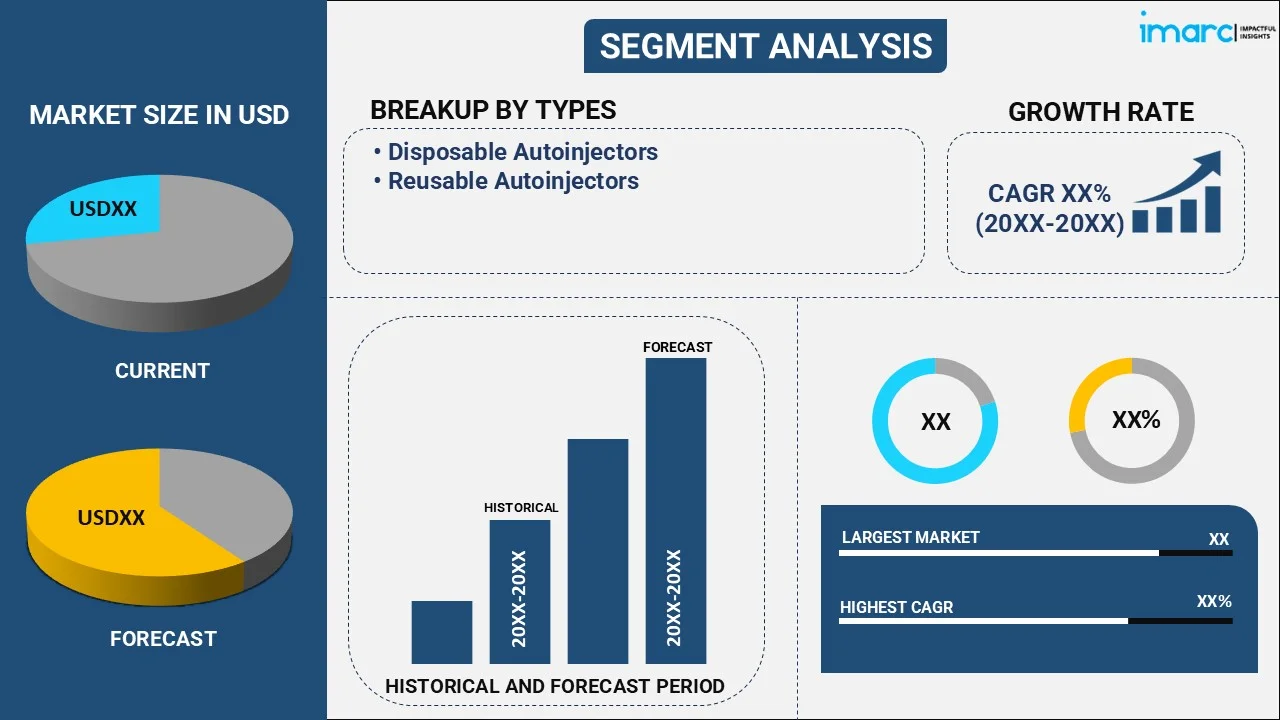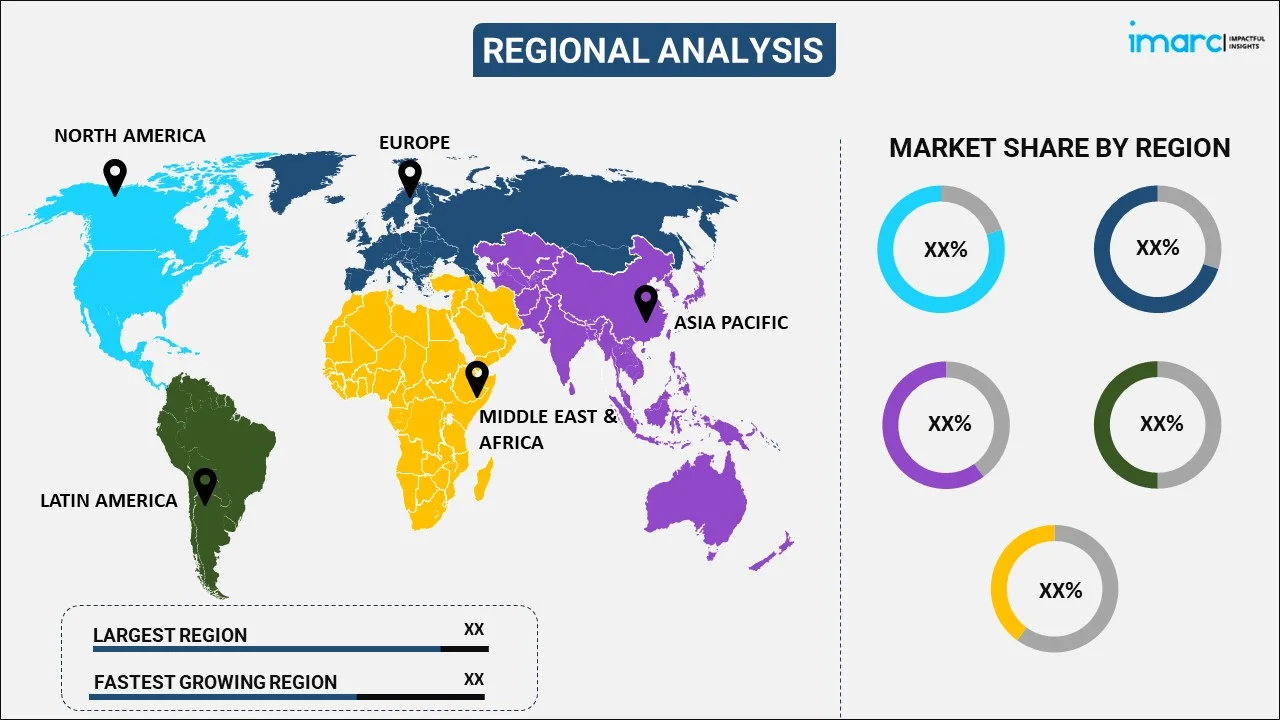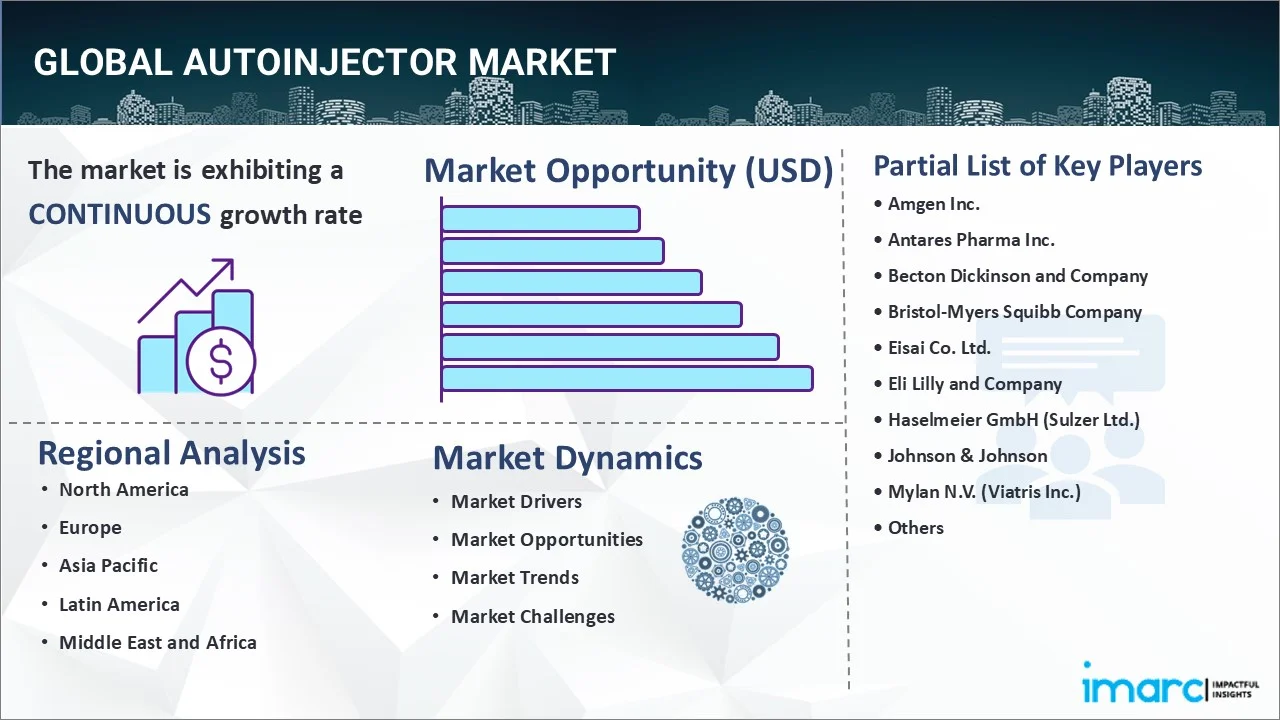
Autoinjector Market Report by Type (Disposable Autoinjectors, Reusable Autoinjectors), Application (Rheumatoid Arthritis, Anaphylaxis, Multiple Sclerosis, and Others), End User (Home Care Settings, Hospitals and Clinics), and Region 2025-2033
Global Autoinjector Market:
The global autoinjector market size reached USD 2.6 Billion in 2024. Looking forward, IMARC Group expects the market to reach USD 8.2 Billion by 2033, exhibiting a growth rate (CAGR) of 13.19% during 2025-2033. The increasing prevalence of chronic diseases, continuous advancements in biologics and biosimilars, the rising preference for home healthcare, numerous product innovations, and supportive reimbursement policies, are some of the factors driving the market.
|
Report Attribute
|
Key Statistics
|
|---|---|
|
Base Year
|
2024
|
|
Forecast Years
|
2025-2033
|
|
Historical Years
|
2019-2024
|
|
Market Size in 2024
|
USD 2.6 Billion |
|
Market Forecast in 2033
|
USD 8.2 Billion |
| Market Growth Rate 2025-2033 | 13.19% |
Autoinjector Market Analysis:
- Major Market Drivers: There is a rise in the prevalence of arthritis, asthma, cancer, chronic obstructive pulmonary disease (COPD), and Alzheimer’s disease. This, along with the growing need for self-administrating medicines, represents one of the key factors driving the market.
- Key Market Trends: Governments of several countries are undertaking initiatives to promote the use of autoinjectors in schools. This, coupled with the increasing awareness among individuals about the benefits of autoinjectors, is propelling the growth of the market. Moreover, the increasing number of regulatory approvals, technological advancements, patent expiry of biologics and the availability of generic versions of autoinjectors are escalating the market's demand.
- Competitive Landscape: Some of the prominent autoinjector market companies include Amgen Inc., Antares Pharma Inc., Becton Dickinson and Company, Bristol-Myers Squibb Company, Eisai Co. Ltd, Eli Lilly and Company, Haselmeier GmbH (Sulzer Ltd.), Johnson & Johnson, Mylan N.V. (Viatris Inc.), Novartis AG, SHL Medical AG, Teva Pharmaceutical Industries Ltd, and Ypsomed Holding AG, among many others.
- Geographical Trends: According to the autoinjector market dynamics, North America leads the overall market. The elderly population in the region is more prone to chronic conditions and often prefers devices that allow easy self-administration of medications, driving the demand for user-friendly autoinjectors.
- Challenges and Opportunities: The high development costs of autoinjectors and high competition from alternative delivery systems are hampering the market's growth. However, the expanding use of biologic drugs, particularly for conditions like cancer, autoimmune diseases, and rare diseases, presents a major opportunity for autoinjectors as these drugs require precise, often long-term administration.
Autoinjector Market Trends:
Growing Geriatric Population
As the elderly population grows, there is an increase in age-related conditions such as osteoarthritis, cardiovascular diseases, and neurodegenerative disorders, all of which require frequent medication administration. For instance, according to the World Health Organization, in 2019, around 528 million individuals worldwide were living with osteoarthritis, a 113% increase from 1990. Approximately 73% of patients with osteoarthritis are older than 55 years. Autoinjectors are being adopted to cater to this, as they simplify the process of self-administration for older patients with limited dexterity. These factors further positively influence the autoinjector market forecast.
Rising Prevalence of Diabetes
There has been a growing number of diabetes cases across various regions, particularly Type 1 diabetes. For instance, according to the U.S. Centers for Disease Control and Prevention, Diabetes has been diagnosed in nearly 352,000 children and adolescents under the age of 20, or 35 per 10,000 young people in the United States. This includes 304,000 people with type 1 diabetes. Also, 1.7 million persons aged 20 and up—or 5.7% of all U.S. adults with diagnosed diabetes—reported having type 1 diabetes and requiring insulin. This has led to an increasing demand for insulin autoinjectors, which allow patients to administer insulin easily and effectively. These factors are expected to propel the autoinjector market in the coming years.
Expanding Biologics Industry
The growing biologics industry is driving the market's growth. For instance, according to IMARC, the global biologics market size reached US$ 349.6 Billion in 2023. Looking forward, IMARC Group expects the market to reach US$ 699.5 Billion by 2032, exhibiting a growth rate (CAGR) of 7.8% during 2024-2032. Biologics, which are used to treat a range of chronic diseases (e.g., cancer, rheumatoid arthritis, psoriasis), often require injection, and autoinjectors are increasingly being used as the preferred method of administration for biologic drugs, thereby boosting the autoinjector market revenue.
Global Autoinjector Industry Segmentation:
IMARC Group provides an analysis of the key trends in each segment of the market, along with forecasts at the global, regional, and country levels for 2025-2033. Our report has categorized the market based on type, application, and end user.
Breakup by Type:

- Disposable Autoinjectors
- Reusable Autoinjectors
Disposable autoinjectors account for the majority of the market share
The report has provided a detailed breakup and analysis of the market based on the type. This includes disposable autoinjectors and reusable autoinjectors. According to the report, disposable autoinjectors represented the largest segment.
According to the autoinjector market outlook, the need for self-administration tools like disposable autoinjectors is being driven by the rising incidence of chronic conditions including diabetes, rheumatoid arthritis, and multiple sclerosis. Moreover, the use of these autoinjectors is growing due to developments in biologic medications and novel treatments. Patients and healthcare providers' adoption of these devices is fueled by their ability to safely and effectively give complicated drugs to patients.
Breakup by Application:
- Rheumatoid Arthritis
- Anaphylaxis
- Multiple Sclerosis
- Others
Rheumatoid arthritis accounts for the majority of the market share
The report has provided a detailed breakup and analysis of the market based on the application. This includes rheumatoid arthritis, anaphylaxis, multiple sclerosis, and others. According to the report, rheumatoid arthritis represented the largest segment.
According to the autoinjector market overview, the treatment of RA is one of the major applications of autoinjectors due to the need for regular, self-administered injections of biologics that help manage the symptoms and progression of the disease. The enhanced convenience and the swift ability to self-administer medication that autoinjectors provide are particularly valuable for RA patients, who often suffer from reduced hand dexterity. These devices are designed to be user-friendly, which is crucial for ensuring adherence to several treatment regimens that can be complex and long-term.
Breakup by End User:
- Home Care Settings
- Hospitals and Clinics
Hospitals and clinics hold the largest share of the industry
A detailed breakup and analysis of the market based on the end user have also been provided in the report. This includes home care settings and hospitals & clinics. According to the report, hospitals & clinics accounted for the largest market share.
As per the autoinjector market research analysis, the market is growing due to the increasing preference for convenient healthcare settings which can be attributed to the high frequency of patient visits to various medical facilities for treatment and management of chronic diseases. This created an augmented demand for convenient and efficient drug delivery methods like autoinjectors. The prominence of these devices in hospitals and clinics is also impelled by the need for devices that ensure precise and safe administration of medications across hospitals and clinics.
Breakup by Region:

- North America
- United States
- Canada
- Asia-Pacific
- China
- Japan
- India
- South Korea
- Australia
- Indonesia
- Others
- Europe
- Germany
- France
- United Kingdom
- Italy
- Spain
- Russia
- Others
- Latin America
- Brazil
- Mexico
- Others
- Middle East and Africa
North America leads the market, accounting for the largest autoinjector market share
The autoinjector market research report has also provided a comprehensive analysis of all the major regional markets, which include North America (the United States and Canada); Asia Pacific (China, Japan, India, South Korea, Australia, Indonesia, and others); Europe (Germany, France, the United Kingdom, Italy, Spain, and others); Latin America (Brazil, Mexico, and others); the Middle East; and Africa. According to the report, North America accounted for the largest market share.
According to the autoinjector market statistics, North America encompasses the largest market share owing to several reasons. The region has an increased prevalence of chronic illnesses like diabetes, multiple sclerosis, and rheumatoid arthritis, which has fueled the demand for self-injection devices, such as auto-injectors. A strong healthcare infrastructure coupled with medical technology advancement and extensive expenditure on health services pushes many patients and doctors into adopting autoinjectors. The country is also home to a large number of key players. For instance, in April 2021, Teva Canada announced a new autoinjector for AJOVY for the preventive treatment of migraine in adults. In addition, positive reimbursement policies and numerous distribution outlets for auto-injectable pens have been instrumental in providing a boost to the industry’s growth.
Competitive Landscape:
Leading companies in the autoinjector industry are propelling market expansion with ongoing innovation and tactical alliances. These massive players in the business make significant investments in R&D to bring new features that improve patient experience and usability, like connectivity choices, electronic monitoring systems, and needle safety mechanisms. Businesses are leading the way in the development of cutting-edge autoinjector technologies and product range expansion. They are also collaborating to expand their market reach and develop new products. For instance, on September 21, 2023, Ypsomed signed an autoinjector supply deal with Novo Nordisk and announced expansion of manufacturing capacities, leading to a 5% rise of the company share value after the market opened. Moreover, they can increase their market reach and provide specialized solutions to satisfy the various demands of patients by forming strategic alliances with pharmaceutical firms and healthcare providers.
The report has provided a comprehensive autoinjector market research report analysis of the competitive landscape. Detailed profiles of all major market companies have also been provided. Some of the key players in the market include:
- Amgen Inc
- Antares Pharma Inc
- Becton Dickinson and Company
- Bristol-Myers Squibb Company
- Eisai Co. Ltd
- Eli Lilly and Company
- Haselmeier GmbH (Sulzer Ltd.)
- Johnson & Johnson
- Mylan N.V. (Viatris Inc.)
- Novartis AG
- SHL Medical AG
- Teva Pharmaceutical Industries Ltd
- Ypsomed Holding AG
(Please note that this is only a partial list of the key players, and the complete list is provided in the report.)
Autoinjector Market Recent Developments:
- August 2024: Astria Therapeutics, Inc., a biopharmaceutical company focused on creating life-changing medicines for allergy and immunological illnesses, selected Ypsomed as a partner in the development of an autoinjector for STAR-0215.
- June 2024: The US Food and Drug Administration (FDA) approved Pharma's tralokinumab-ldrm (Adbry) autoinjector for individuals with moderate to severe atopic dermatitis.
- June 2024: Instron launched the next generation Autoinjector Testing System, which enables full functionality testing of pens and autoinjectors to ISO 11608.
Autoinjector Market Report Scope:
| Report Features | Details |
|---|---|
| Base Year of the Analysis | 2024 |
| Historical Period | 2019-2024 |
| Forecast Period | 2025-2033 |
| Units | Billion USD |
| Scope of the Report | Exploration of Historical Trends and Market Outlook, Industry Catalysts and Challenges, Segment-Wise Historical and Future Market Assessment:
|
| Types Covered | Disposable Autoinjectors, Reusable Autoinjectors |
| Applications Covered | Rheumatoid Arthritis, Anaphylaxis, Multiple Sclerosis, Others |
| End Users Covered | Home Care Settings, Hospitals and Clinics |
| Regions Covered | Asia Pacific, Europe, North America, Latin America, Middle East and Africa |
| Countries Covered | United States, Canada, Germany, France, United Kingdom, Italy, Spain, Russia, China, Japan, India, South Korea, Australia, Indonesia, Brazil, Mexico |
| Companies Covered | Amgen Inc., Antares Pharma Inc., Becton Dickinson and Company, Bristol-Myers Squibb Company, Eisai Co. Ltd., Eli Lilly and Company, Haselmeier GmbH (Sulzer Ltd.), Johnson & Johnson, Mylan N.V. (Viatris Inc.), Novartis AG, SHL Medical AG, Teva Pharmaceutical Industries Ltd., Ypsomed Holding AG, etc. |
| Customization Scope | 10% Free Customization |
| Post-Sale Analyst Support | 10-12 Weeks |
| Delivery Format | PDF and Excel through Email (We can also provide the editable version of the report in PPT/Word format on special request) |
Key Benefits for Stakeholders:
- IMARC's report offers a comprehensive quantitative analysis of various market segments, historical and current market trends, market forecasts, and dynamics of the autoinjector market from 2019-2033.
- The research study provides the latest information on the market drivers, challenges, and opportunities in the global autoinjector market.
- The study maps the leading, as well as the fastest-growing, regional markets. It further enables stakeholders to identify the key country-level markets within each region.
- Porter's five forces analysis assists stakeholders in assessing the impact of new entrants, competitive rivalry, supplier power, buyer power, and the threat of substitution. It helps stakeholders to analyze the level of competition within the autoinjector industry and its attractiveness.
- The competitive landscape allows stakeholders to understand their competitive environment and provides insight into the current positions of key players in the market.
Key Questions Answered in This Report
The global autoinjector market was valued at USD 2.6 Billion in 2024.
We expect the global autoinjector market to exhibit a CAGR of 13.19% during 2025-2033.
The high prevalence of several chronic ailments, along with the growing prominence of self- administrative medicines, is primarily driving the global autoinjector market.
The sudden outbreak of the COVID-19 pandemic has led to the rising demand for autoinjectors to self-inject drugs for treating various emergency cases and reducing the risk of the coronavirus infection upon hospital visits or interaction with healthcare professionals.
Based on the type, the global autoinjector market can be categorized into disposable autoinjectors and reusable autoinjectors, where disposable autoinjectors currently exhibit clear dominance in the market.
Based on the application, the global autoinjector market has been segmented into rheumatoid
arthritis, anaphylaxis, multiple sclerosis, and others. Among these, anaphylaxis represents the largest market share.
Based on the end user, the global autoinjector market can be bifurcated into home care settings and hospitals and clinics. Currently, home care settings account for the majority of the total market share.
On a regional level, the market has been classified into North America, Europe, Asia-Pacific, Middle East and Africa, and Latin America, where North America currently dominates the global market.
Some of the major players in the global autoinjector market include Amgen Inc., Antares Pharma Inc., Becton Dickinson and Company, Bristol-Myers Squibb Company, Eisai Co. Ltd., Eli Lilly and Company, Haselmeier GmbH (Sulzer Ltd.), Johnson & Johnson, Mylan N.V. (Viatris Inc.), Novartis AG, SHL Medical AG, Teva Pharmaceutical Industries Ltd., and Ypsomed Holding AG.
Need more help?
- Speak to our experienced analysts for insights on the current market scenarios.
- Include additional segments and countries to customize the report as per your requirement.
- Gain an unparalleled competitive advantage in your domain by understanding how to utilize the report and positively impacting your operations and revenue.
- For further assistance, please connect with our analysts.

 Request Customization
Request Customization
 Speak to an Analyst
Speak to an Analyst
 Request Brochure
Request Brochure
 Inquire Before Buying
Inquire Before Buying




.webp)




.webp)












